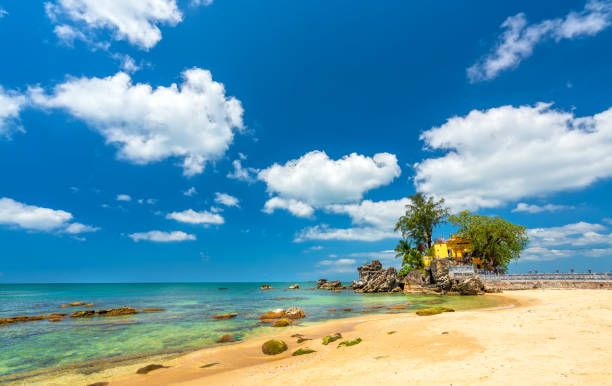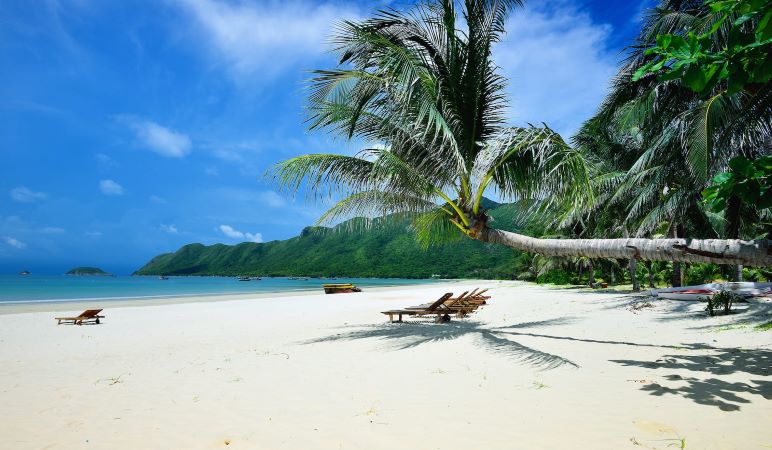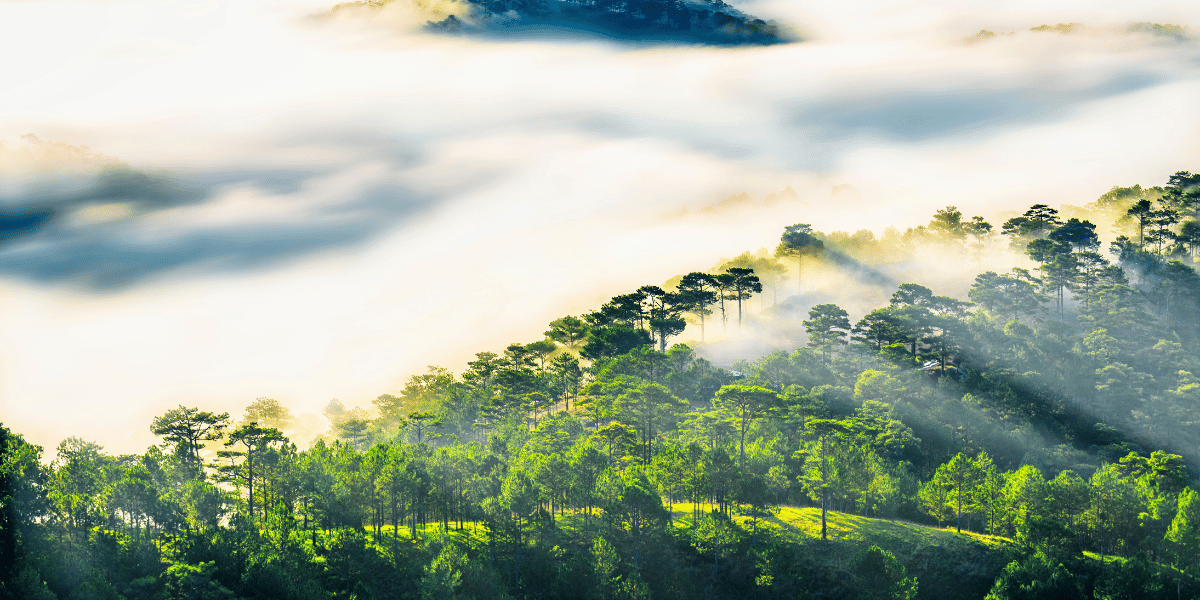Best Vietnam Islands: Discover the Hidden Gems of Vietnam’s Coastline
Last Updated on 11 February, 2025 by admin
Vietnam is celebrated worldwide for its breathtaking landscapes, rich history, and vibrant culture. Among its many natural treasures, the islands of Vietnam shine as true gems of the Vietnamese coastline, offering a perfect blend of pristine beaches, lush forests, and unique cultural experiences.
From the famous islands in Vietnam like Phu Quoc and Con Dao to hidden gems such as Dao Hon Tre and the secluded shores near Nha Trang, these islands cater to every traveler’s dream. Whether you’re searching for adventure, relaxation, or a combination of both, Vietnam’s best islands provide an unforgettable escape.
For those who crave exploration, the vibrant coral reefs around the islands are ideal for snorkeling and diving. If relaxation is your goal, the hidden beaches in Vietnam offer tranquil settings to unwind. Meanwhile, southern Vietnam islands like Phu Quoc boast luxury resorts and a lively food scene, while northern Vietnam islands near Hanoi promise scenic trails and serene waters.
This guide delves into the most beautiful islands in Vietnam, uncovering key attractions and activities that make each destination unique. Whether it’s the historical depth of Con Dao, the lively atmosphere of a party island, or the quiet charm of hidden gem islands, Vietnam’s coastline has something for every type of traveler.
Let this guide inspire your next adventure and help you plan your dream getaway to the best islands in Vietnam, where natural beauty and cultural richness converge to create a tropical paradise.
Phu Quoc Island
Phu Quoc Island, nestled in the Gulf of Thailand, is the largest and one of the most iconic Vietnamese islands, renowned for its pristine beaches, crystal-clear waters, and lush tropical landscapes. Often referred to as the “Pearl Island of Vietnam,” this destination offers a harmonious blend of natural beauty and modern amenities, making it a top choice for both adventure seekers and relaxation enthusiasts.

The island’s most famous beaches, Long Beach (Bai Truong) and Sao Beach (Bai Sao), are ideal for sunbathing, swimming, and a variety of water sports. With their powdery white sands and turquoise waters, these beaches are often considered among the best islands in Vietnam for beach lovers. Hidden beaches in Phu Quoc, like Ong Lang Beach, offer quieter spots for those seeking solitude amidst nature.
Beyond the beaches, Phu Quoc National Park, a UNESCO Biosphere Reserve, invites visitors to explore its tropical forests and discover its diverse wildlife. Hiking trails wind through lush greenery, providing breathtaking views and an immersive experience in the island’s natural wonders. The park is a haven for nature enthusiasts and a prime example of hidden gems of Vietnam.
For underwater explorers, snorkeling and diving are must-try activities. The vibrant coral reefs around the An Thoi Archipelago and Fingernail Island are home to colorful marine life, making Phu Quoc one of the best islands in Vietnam for underwater adventures. Boat tours often include stops at these sites, providing a chance to swim and snorkel in pristine waters.
Phu Quoc is not only about natural beauty; its cultural attractions also stand out. Visit traditional fishing villages, tour pepper farms, or explore the famous Phu Quoc fish sauce factories to get a taste of the island’s heritage. These experiences connect visitors to the local charm of Vietnam’s islands.
Whether you’re seeking luxury resorts, hidden trails, or vibrant underwater ecosystems, Phu Quoc Island has it all. It’s a tropical paradise that encapsulates the best of Vietnam’s coastline, offering unforgettable experiences for every type of traveler.
Cat Ba Island – The Crown Jewel of Ha Long Bay
Cat Ba Island, the largest island in the iconic Ha Long Bay, is a treasure trove of rugged landscapes, serene waters, and extraordinary biodiversity. Known as one of the hidden gems of Vietnam, this destination seamlessly blends natural beauty with adventure, making it a haven for nature enthusiasts and thrill-seekers alike.
The island’s highlight is Cat Ba National Park, a UNESCO-recognized reserve and one of the most biologically diverse areas in Vietnam. The park boasts excellent hiking trails that lead through dense forests, limestone hills, and wetlands, offering panoramic views and the chance to encounter rare wildlife. Among its most notable inhabitants is the critically endangered Cat Ba langur, one of the world’s rarest primates. Exploring this park is a must for anyone visiting Cat Ba Island, as it showcases the island’s commitment to conservation and eco-tourism.
Adjacent to Cat Ba lies Lan Ha Bay, a quieter and less crowded alternative to Ha Long Bay, with equally stunning scenery. This bay, dotted with countless limestone islets and hidden beaches, is ideal for kayaking, paddleboarding, and rock climbing. Paddle through calm waters, explore secluded lagoons, or scale the cliffs of towering karsts for an unmatched adventure experience. Lan Ha Bay is a testament to why Cat Ba Island is among the best islands in Vietnam for eco-tourism and outdoor activities.
For those seeking more adventure, Cat Ba’s caves and grottos add a touch of mystery to the island. Famous sites like Hospital Cave, which served as a secret wartime hospital, and Trung Trang Cave, with its intricate stalactite formations, offer fascinating insights into both the island’s natural history and its role in Vietnam’s past.
Whether you’re exploring the island’s lush tropical forests, paddling through serene bays, or delving into its mysterious caves, Cat Ba Island promises a unique and unforgettable experience. As a hub for eco-tourism and a gateway to the breathtaking beauty of Lan Ha Bay, Cat Ba Island is undoubtedly one of Vietnam’s best islands for nature and adventure lovers alike.
Con Dao Islands – A Hidden Paradise with a Historic Legacy
The Con Dao Islands, a remote archipelago off the southern coast of Vietnam, offer a unique combination of unspoiled natural beauty and deep historical significance. This chain of islands, often regarded as one of the hidden gems of Vietnam, is a must-visit destination for travelers seeking both tranquility and cultural discovery.

The largest and most prominent of the islands is Con Son, a place steeped in history. Once home to a notorious prison during the French colonial period, Con Son bears witness to Vietnam’s past struggles for independence. Visitors can explore the Con Dao Prison Complex, including the infamous Tiger Cages, which provide sobering insights into the resilience of the human spirit. This blend of natural splendor and historical depth makes Con Dao Islands truly unique among Vietnam’s islands.
Beyond its historical significance, Con Dao is a haven for nature lovers. The pristine An Hai Beach and its nearby secluded shores offer soft white sands and crystal-clear waters, ideal for sunbathing and relaxation. The Con Dao National Park, a UNESCO-recognized marine and terrestrial reserve, is home to diverse wildlife, including rare birds and the green sea turtles that nest on its beaches. Watching turtles lay their eggs at night is an unforgettable experience, showcasing the island’s commitment to eco-tourism and conservation.
For underwater enthusiasts, the Con Dao Islands are among the best islands in Vietnam for diving and snorkeling. The waters surrounding the archipelago are teeming with vibrant coral reefs and diverse marine life, including tropical fish, rays, and even dugongs. Popular dive sites like Bay Canh Island and Hon Tai reveal an underwater world of breathtaking beauty, attracting divers from around the globe.
Whether you’re trekking through lush forests, exploring the historical remnants of Con Son, or diving into the clear waters of its surrounding seas, the Con Dao Islands offer an unparalleled blend of natural beauty and cultural heritage. This remote archipelago is a true tropical paradise and a testament to the diversity of Vietnam’s coastline, making it an essential destination for those seeking adventure, history, and serenity.
Cham Islands – A Marine Paradise off the Coast of Hoi An
The Cham Islands (Cu Lao Cham), located just off the coast of Hoi An, are a group of eight picturesque islets renowned for their rich marine biodiversity and stunning natural landscapes. Recognized as a UNESCO Biosphere Reserve, this archipelago is an essential destination for eco-tourism enthusiasts and nature lovers seeking off-the-beaten-path Vietnam experiences.
At the heart of the islands lies the Cu Lao Cham Marine Park, a sanctuary teeming with vibrant coral reefs, tropical fish, and other marine life. This biosphere reserve provides a perfect setting for snorkeling and diving, making the Cham Islands one of the best islands in Vietnam for underwater exploration. Whether you’re a seasoned diver or a beginner, the clear waters and thriving marine ecosystems promise an unforgettable adventure.
Beyond their natural beauty, the Cham Islands offer a glimpse into Vietnam’s coastal traditions. The islands’ traditional fishing villages, such as Bai Lang, allow visitors to experience local life and witness the community’s strong connection to the sea. These villages reflect the charm and simplicity of hidden gems of Vietnam, offering cultural insights and warm hospitality.
Eco-tourism plays a significant role in preserving the islands’ pristine environment. Visitors can participate in conservation activities, such as coral restoration projects or beach clean-ups, contributing to the sustainability of this fragile ecosystem. The islands’ sandy beaches, such as Bai Chong and Bai Ong, provide idyllic spots to relax, swim, or enjoy a leisurely picnic while surrounded by the natural beauty of the Vietnamese coastline.
Food lovers will also find plenty to enjoy, as the Cham Islands are known for their fresh seafood. Local dishes such as grilled squid, steamed clams, and seafood hotpot showcase the bounty of the sea and the culinary traditions of the region.
Whether you’re exploring the vibrant marine life, immersing yourself in the culture of traditional fishing villages, or simply basking on a tranquil beach, the Cham Islands offer a harmonious blend of adventure, relaxation, and cultural discovery. This eco-friendly destination is a true tropical paradise and a shining example of Vietnam’s commitment to sustainable tourism.
Binh Ba Island – A Hidden Gem Known as Lobster Island
Binh Ba Island, affectionately called Lobster Island, is a small yet captivating destination located off the coast of Cam Ranh in southern Vietnam. Renowned for its pristine beaches, crystal-clear waters, and mouthwatering seafood, this hidden gem of Vietnam is a perfect retreat for those seeking tranquility and a taste of authentic coastal life.
One of the island’s highlights is Bai Nom Beach, a favorite spot for swimming, sunbathing, and soaking in the serene beauty of the Vietnamese coastline. The soft white sands and calm turquoise waters provide an idyllic setting for relaxation. For those looking to explore beneath the waves, snorkeling and diving are must-try activities. The vibrant marine life and colorful coral reefs surrounding the island make it a paradise for underwater enthusiasts.
No trip to Binh Ba Island would be complete without indulging in its famed lobster dishes, earning the island its nickname. Local markets and seaside restaurants serve a variety of fresh seafood, including grilled lobsters, seafood hotpots, and other delicacies that showcase the region’s culinary prowess. A visit to these markets also offers a glimpse into the daily life of the island’s fishing communities.
Beyond the beaches, Binh Ba’s tranquil atmosphere and slower pace of life create a refreshing escape from the hustle and bustle of the mainland. Whether you’re strolling along its quiet shores, enjoying a picnic by the sea, or engaging with the friendly locals, the island offers a sense of simplicity and connection with nature.
Binh Ba Island is also a testament to eco-tourism in Vietnam, with efforts to preserve its natural beauty and protect its marine ecosystems. Visitors are encouraged to respect the environment, ensuring that the island remains one of Vietnam’s best-kept secrets.
Whether you’re drawn by its stunning beaches, world-class seafood, or laid-back charm, Binh Ba Island promises an unforgettable experience. As one of the best islands in Vietnam, it perfectly encapsulates the allure of hidden gems along the country’s breathtaking coastline.
Ly Son Island – The Volcanic Gem of Vietnam’s Coastline
Often called the “Jeju of Vietnam,” Ly Son Island is a breathtaking destination off the coast of Quang Ngai Province, celebrated for its volcanic landscapes, unique culture, and thriving garlic farms. This small island offers a captivating blend of rugged natural beauty and local charm, making it one of the hidden gems of Vietnam and a must-visit for nature enthusiasts and cultural explorers alike.
One of Ly Son’s most iconic landmarks is the To Vo Gate, a natural stone arch formed by volcanic activity. This stunning structure, set against the backdrop of the blue sea, is a favorite spot for photography, especially at sunrise and sunset. Nearby, the Hang Pagoda, a centuries-old temple nestled within a cave, combines spiritual tranquility with natural wonder, offering visitors a serene retreat and a glimpse into the island’s cultural heritage.
Adventurers can hike up the island’s volcanic craters, such as Thoi Loi Peak, for panoramic views of Ly Son and the surrounding waters. The sight of the emerald sea meeting the dark volcanic rocks creates a dramatic and unforgettable landscape. These craters are not just geological wonders but also serve as a reminder of Ly Son’s volcanic origins, which have shaped its unique terrain.
Ly Son Island is also renowned as the garlic capital of Vietnam, with its fertile volcanic soil producing some of the finest garlic in the country. Visitors can explore the island’s garlic farms, learning about traditional farming methods and sampling dishes infused with this local specialty. From garlic-flavored seafood to aromatic condiments, the island’s cuisine highlights the versatility of this prized crop.
The island’s pristine beaches and clear waters provide opportunities for relaxation and exploration. Hidden coves and rocky shores invite visitors to unwind while soaking in the unspoiled beauty of the Vietnamese coastline.
Whether you’re marveling at volcanic formations, savoring garlic-infused dishes, or hiking to panoramic viewpoints, Ly Son Island offers a unique travel experience that combines natural beauty, cultural depth, and a taste of local life. As one of the best islands in Vietnam, it showcases the extraordinary diversity of the country’s hidden gems and is a destination not to be missed.
Nam Du Islands – A Serene Escape in Southern Vietnam
Nestled off the southern coast of Vietnam, the Nam Du archipelago is a hidden paradise comprising 21 stunning islands. Known for its pristine beaches, crystal-clear waters, and untouched natural beauty, this remote destination is one of the hidden gems of Vietnam, offering a tranquil retreat away from the crowds of more touristy hotspots.
Among the most popular islands in the archipelago are Hon Ngang and Hon Dau, each boasting its own unique charm. Hon Ngang, the archipelago’s main island, features a vibrant fishing village where visitors can explore local life, sample fresh seafood, and interact with friendly residents. Meanwhile, Hon Dau, with its lush greenery and secluded beaches, is perfect for those seeking tranquility and an escape into nature. These islands are ideal for snorkeling, allowing travelers to discover the vibrant coral reefs and marine life that thrive in the surrounding waters.
Island hopping is one of the most exciting ways to explore the Nam Du archipelago, offering the opportunity to visit multiple islands, each with its own character and attractions. Whether it’s relaxing on the white sands of Bai Men Beach, enjoying a boat ride across turquoise waters, or discovering hidden coves, the archipelago provides countless picturesque spots for relaxation and adventure.
Fishing is another popular activity in Nam Du, reflecting the islands’ deep connection to the sea. Visitors can join local fishermen for an authentic experience, learning traditional methods and enjoying the satisfaction of catching their own seafood. For those interested in cultural exploration, the islands’ small villages offer a glimpse into the simple and harmonious way of life of the local communities.
The untouched nature of the Nam Du Islands makes them a perfect retreat for those looking to escape the hustle and bustle of city life. With their laid-back atmosphere, breathtaking landscapes, and welcoming locals, the islands offer an idyllic setting for travelers to unwind and reconnect with nature.
Whether you’re snorkeling in vibrant coral reefs, hopping between scenic islands, or simply basking in the tranquility of Vietnam’s coastline, the Nam Du archipelago promises an unforgettable experience. As one of the best islands in Vietnam, it perfectly captures the essence of hidden gems in southern Vietnam.
Binh Hung Island – A Tranquil Coastal Escape
Binh Hung Island, a hidden gem of Vietnam, is located near the coastal city of Cam Ranh. This small yet captivating island is renowned for its pristine beaches, clear blue waters, and laid-back atmosphere, making it a perfect destination for those seeking a peaceful retreat amidst the natural beauty of southern Vietnam.
Among the island’s most popular attractions is Binh Tien Beach, a serene stretch of white sand bordered by turquoise waters. Perfect for swimming and relaxation, this beach offers an idyllic escape from the hustle and bustle of the mainland. Another must-visit site is the Hon Chut Lighthouse, perched on a hill and offering panoramic views of the island and its surrounding seas. The lighthouse is a favorite spot for photographers and nature lovers, especially during sunrise and sunset when the scenery is particularly breathtaking.
For those eager to explore more of Binh Hung Island, boat tours around the island are highly recommended. These tours provide a unique perspective of the island’s hidden coves, rocky shores, and untouched natural beauty, making them a highlight for visitors. Snorkeling opportunities abound as well, with the island’s crystal-clear waters revealing vibrant coral reefs and marine life.
Food enthusiasts will find Binh Hung a paradise, especially for seafood lovers. The island is famous for its lobster dishes, often served freshly grilled or in a savory hotpot. Local seafood markets and seaside restaurants also offer a variety of other delicacies, such as steamed crab, grilled squid, and clam soup, all prepared with the freshest ingredients from the surrounding waters. Sampling these dishes is a must-do for any visitor.
Whether you’re savoring the island’s local seafood, exploring its natural landmarks, or simply soaking up the sun on its pristine beaches, Binh Hung Island offers an authentic and relaxing experience. As one of the best islands in Vietnam, it perfectly showcases the charm and beauty of hidden gems along the Vietnamese coastline.
Phu Quy Island – A Remote Haven of Natural Beauty and Culture
Phu Quy Island, located off the coast of Binh Thuan Province, is a hidden treasure that perfectly combines natural beauty with a rich cultural heritage. Known for its untouched beaches, rugged landscapes, and spiritual landmarks, this remote island offers a unique and tranquil retreat for travelers seeking an authentic off-the-beaten-path Vietnam experience.
One of the island’s most iconic attractions is the Van An Thanh Whale Temple, a fascinating cultural site where locals honor whales, regarded as guardians of fishermen. The temple houses an impressive collection of whale skeletons and offers insights into the island’s spiritual traditions and maritime history. Another highlight is Cao Cat Mountain, a striking natural landmark where visitors can enjoy panoramic views of the island’s rugged terrain and surrounding turquoise waters. Hiking to the mountain’s peak is a must for those seeking both adventure and breathtaking scenery.
Phu Quy Island is also a paradise for adventure enthusiasts. The island’s strong coastal winds make it an excellent destination for windsurfing and other water sports. For those who prefer a more relaxed pace, exploring the island’s traditional temples and small fishing villages offers a glimpse into the simple yet vibrant life of the local community.
The island’s untouched beaches, such as Bai Nho and Ganh Hang, provide serene settings for swimming, sunbathing, and unwinding. These hidden gems of Vietnam’s coastline offer crystal-clear waters and soft sands, making them ideal for travelers looking to escape the crowds.
Phu Quy’s culinary offerings add to its charm, with local seafood being a standout. Freshly caught fish, squid, and crabs are transformed into delicious dishes that reflect the island’s coastal culture. Dining on the island offers a true taste of its traditions and connection to the sea.
Whether you’re admiring the spiritual significance of the Van An Thanh Whale Temple, trekking up Cao Cat Mountain, or relaxing on the island’s pristine beaches, Phu Quy Island promises an unforgettable experience. This remote haven is a shining example of Vietnam’s hidden gems, offering a perfect blend of adventure, culture, and tranquility.
Hon Tre Island – A Luxurious Escape Near Nha Trang
Hon Tre Island, located just off the coast of Nha Trang, is a premier destination renowned for its luxurious resorts, world-class amenities, and vibrant entertainment options. Known as one of the best islands in Vietnam for relaxation and recreation, this island seamlessly blends natural beauty with modern sophistication, making it a perfect getaway for families, couples, and luxury travelers.
One of Hon Tre’s most famous attractions is Vinpearl Land, a sprawling amusement park that offers a wide range of activities for all ages. From thrilling roller coasters and water slides to an aquarium and a cultural village, Vinpearl Land ensures fun and excitement for everyone. The park is easily accessible via a scenic cable car ride, providing breathtaking views of Nha Trang Bay along the way.
For those seeking tranquility, Bai Tru Beach is a must-visit spot. This pristine beach, with its white sand and crystal-clear waters, is ideal for swimming, sunbathing, or simply soaking in the serene surroundings. The calm waters make it a favorite for families, while the picturesque backdrop provides a stunning setting for relaxation.
Upscale resorts on Hon Tre Island, including the renowned Vinpearl resorts, offer unparalleled luxury with private villas, infinity pools, fine dining, and spa facilities. These resorts cater to every need, ensuring a lavish and stress-free vacation. Whether enjoying a couples’ retreat or a family holiday, guests are treated to top-tier hospitality and a variety of recreational options, including golf courses and water sports.
Beyond its modern attractions, Hon Tre Island retains a sense of natural charm. Visitors can explore its scenic trails, lush greenery, and hidden coves, providing opportunities to connect with nature amidst the island’s luxurious offerings.
Whether you’re diving into the thrills of Vinpearl Land, relaxing on the pristine shores of Bai Tru Beach, or indulging in the comfort of a five-star resort, Hon Tre Island delivers an unforgettable experience. This hidden gem near Nha Trang is the epitome of Vietnam’s coastline luxury, offering something for every traveler.
Conclusion
Vietnam’s islands are a testament to the country’s natural beauty and cultural richness. From the bustling Phu Quoc to the serene Nam Du archipelago, each island offers unique experiences and attractions. Whether you’re looking for adventure, relaxation, or cultural immersion, Vietnam’s islands have something to offer. Exploring these island destinations provides a deeper appreciation for the diverse landscapes and traditions that make Vietnam a must-visit destination. Plan your island getaway and discover the hidden gems of Vietnam’s coastline.
By optimizing each section with relevant keywords and providing detailed, engaging content, this article not only informs readers but also helps improve its visibility in search engine results.




